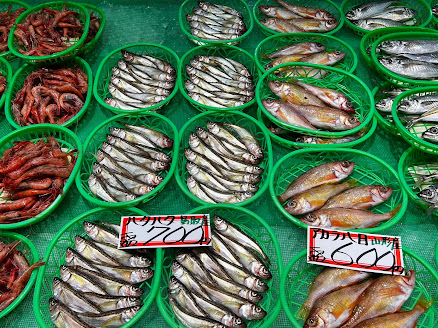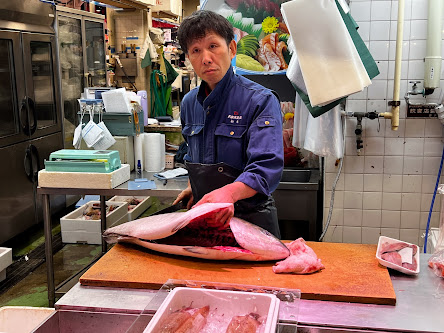The Intrepid brochure described the Highlights of Japan trip as eight days, but the first day is arrival with a welcome meeting at 6:00 pm and the last day is farewell departing at 8:00 am. So we really only had six days. All travel companies do this. So on our last day we said farewell to our travel companions, slipped Shu his well deserved tip and made sure Brynne and Connor departed early enough to get the Shinkansen train to Tokyo then transfer to the airport in plenty of time for their flight. They were all experienced travelers now and texted that all went according to plan. There were now just three of us.
One of my goals for this next portion was to see less "big city" Japan with many foreign tourists and to explore off the beaten path with a walk in the mountains. This time I arranged it with Inside Japan who does both group tours, and self-guided for independent travelers who just want the planning and advanced reservations. Though less total time than the first half, we still had six days on our way back to Tokyo.
We retrieved our train tickets and after leaving Brynne and Connor headed across Honshu island to to Kanazawa on the Sea of Japan.
Previously shown map of our self-guided tour
Kanazawa is the second largest city not to be destroyed by US bombing after Kyoto. Therefore many historic neighborhoods remain intact. There's the Geisha neighborhood and the Samurai neighborhood. And of course castles, gardens, temples, and shrines.
For the rest of this trip Inside Japan booked us in Ryokans, a traditional Japanese Inn. These are simple rooms with tatami mats on the floor and little furniture. Our first night they reserved a multi-course dinner in our room sitting on the floor traditional style, but uncomfortable for seventy year old knees. After dining the table was moved aside and our futon beds were gathered from behind sliding doors and unfolded. For the next five nights we all shared one room. Much to Teigan's dismay, she had two seventy year olds that serenaded her each night. But I brought ear plugs for her.
Ryokan in Kanasawa.
Typical Samurai home
Samurai garden
Rural areas in Japan, gas stations, and even bathrooms at trail heads, are equipped with bottom-washing toilet seats. However, Japan receives many Chinese visitors where squat toilets are the norm. To provide caution against inappropriate behavior (and excessive floor cleaning), signs are often posted above flush toilets to advise visitors how to use the toilet in the most basic way.
Sign in public bathroom
Kanazawa Castle and Kenrokuen Garden Map
Kanazawa Castle, built in the fifteenth century, burned down in the nineteenth century and rebuilt in the twentieth
Detail of entry gates
Original details remain
Rated one of the most delightful gardens in Japan, Kenrokuen, coming out of the winter season
While in the larger cities tourists dress up in traditional outfits, here they walk the talk.
One of many traditional gates to the moated fortress
In all our travels, whether towns in Europe or third world countries, we love to visit markets. They offer insights into another culture by what they sell and how they sell it. Wonderful refrigerated cheeses in France, dangling sausages in Germany and Italy, spices in the Middle East piled in wonderfully colorful cones, or bloody animal parts splayed on grass covered newspapers in China. But few display food stuffs better than Japan, which has a cultural bias toward design.
Ochaya Shima Market
Assortment of fishes I've never seen
Freshly cut to order for you
Even body parts we typically don't see kidneys (above), brains, heart and lungs are all on display
And fruits are often prepared for gifts in fancy padded boxes
Our guide arranged for us to experience a Tea Ceremony, known as Chanoyu. This involves a series of steps that emphasize respect, purity, harmony, and tranquility. This is not about having a cup of tea, it is performance art. We were walked through it and then got to emulate each stage of the performance.
1. Bowing:
The tea master enters the room and bows, with the guests bowing back in a sign of humility. 2. Purification:
The tea master purifies and prepares the utensils used in the ceremony, often including the tea bowl, whisk, and other tools. 3. Tea Preparation:
The tea master then prepares the matcha tea, whisking it to create a frothy texture. 4. Serving:
The tea is served to the guests in a specific order, typically starting with the most honored guest.
Accepting and Drinking the Tea:
1. Receiving the Bowl:
When the tea bowl is presented, the guest takes it with their right hand and places it on their left palm. 2. Rotating the Bowl:
The guest rotates the bowl slightly to avoid drinking from the front, where the previous guest's lips may have touched it. 3. Taking a Sip:
The guest takes a few sips of the tea, savoring each one. 4. Expressing Gratitude:
After finishing, the guest wipes the rim of the bowl and returns it to the host, bowing to express gratitude.

The woman in blue explained each step, while the Master performed.
Every movement is slow and deliberate, including folding and tucking the napkin into Haramaki (belly-band).
I noticed this attention to grace and respect throughout everyday encounters in Japan. While riding the train, the conductor would stand erect when leaving through the connecting door between cars and politely bow to everyone before departing to the next car - though nobody watched him. The host in a restaurant guiding you to your seat would direct you with one hand on their heart and an the other outstretched arm toward the seat, with palm flat and fingers held tight together like a blade. Upon sitting they'd bow before departing.
Whatever they imported over the centuries from other cultures, most notably from China, they'd refine. The Chinese characters became simplified Kanji, the Chinese rock gardens refined abstractions of the sea, and the ink paintings become more subtle and elegant with the slightest stroke.
After the ceremony we walked the Kenrokuen gardens again.
Cherry trees blooming
How brief the blooms, then become like pink snow.
Waterfalls and Lantern
Mitered thatched roof
Torii Gates with prayers
After weeks of rice and fish we finally broke down and had Wagu Beef burgers
In Kyoto Connor and I succumbed to buying a Japanese knife, but I still needed to look for more
Besides the Samurai district the other historic area in Kanazawa is the Higashi Chaya district. This was an area established for entertainment with geigi (Kanazawa's name for geisha). Over the years chaya districts were permitted, abolished and permitted again. Geishas were not prostitutes, those were the women of the willow world. Geishas were educated to entertain with poetry, dance, song, witty (but not too witty) conversation and their porcelain beauty.
Historic Geishi district
Historic Interior or traditional home
Historic home garden lantern and deer scarer
(Water would pour from the upper bamboo pipe to fill the lower, which would tip to spill the water
into the bowl. When empty it would tip back and the end smack the rock with a sound)
Street scene later in day
Sake Tasting
Evening along river
Next Post: Mountains Villages of Japan and Edo Road to Tokyo

































No comments:
Post a Comment